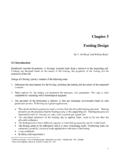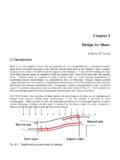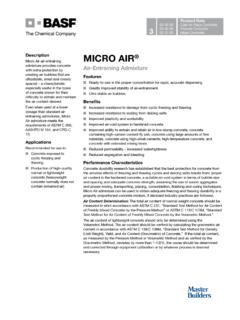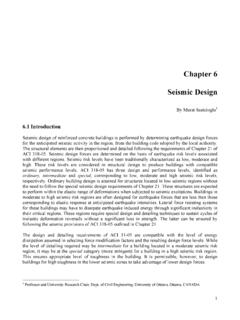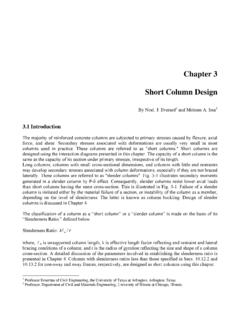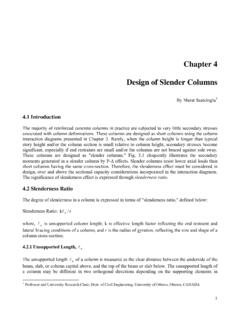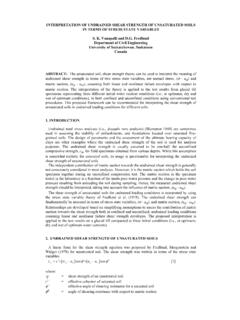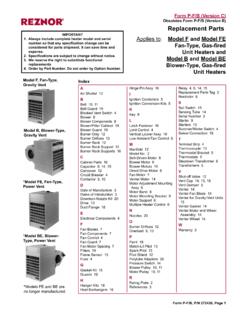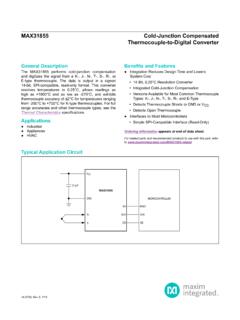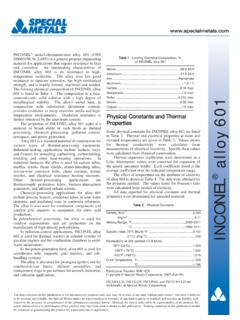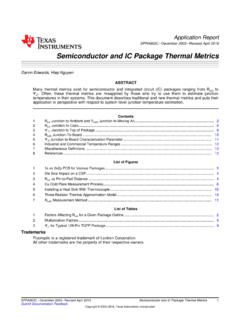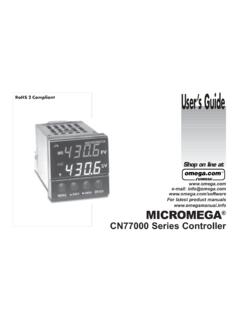Transcription of SOLUTIONS TO PROBLEMS FROM CHAPTER 2 - Engineering
1 SOLUTIONS TO PROBLEMS FROM CHAPTER 2 A K thermocouple produces a voltage which is measured by the potentiometer as 25mV. Determine the temperature T when the Reference Junction isothermal block is indicated by a thermistor as 0 oC. Use the Seebeck coefficient for 20oC. Solution At 0 oC., the two junctions produce each voltages of 0 V. For the Seebeck coefficient at 20 oC of 40 V/o C, the temperature at junction J is T = (25000 V) /( 40 V/o C) = 625 oC This temperature is much higher than 20 oC and, consequently, the result using the Seebeck coefficient for 20oC is approximate.
2 A much more precise result can be obtained using NIST table or p(V) polynomial for K thermocouple . A PC based data acquisition system is considered for a K type thermocouple . Two limit designs will have to be evaluated. Design a) a cheap and less accurate design with: -a 4-bit A/D converter; -a standard electronic reference junction block with a temperature uncertainty of C at 00 C; -a standard thermocouple with C error limit. 1 Design b) an expensive and more accurate design with: -a 8-bit A/D converter -a special electronic reference junction block with a temperature uncertainty of C at 00 C; -a special thermocouple with C error limit.
3 Compare the two designs based on the following calculations: 1) Determine scale range for the analog input voltage in A/D converter; 2) Calculate the resolution; 3) Calculate the combined uncertainty (of A/D converter, Reference Junction and thermocouple ) regarding the temperature measurement. Solution 1) K thermocouple can measure temperatures up to a maximum of 1372 0 C. Using the Seebeck coefficient at 20 oC of 40 V/o C, this gives the approximate maximum voltage output of (1372 0 C)( 40 V/o C) = mV.
4 0 to V and 0 to 10 V). If 0-10V, 0-01 V and V (0-100 mV) ranges are available, the range -100 mV should be chosen, such that the thermocouple output, with unipolar voltages in the domain 0 to mV, covers most of the 0 to 100 mV range. 2 2) For the 4-bit converter of the design a, 2 4 = 16 distinct digital readings are possible, a resolution of 100 [mV]/ 16 = [mV] or [mV]*100/100 [mV] = % of the scale range. For a 8-bit converter of the design b, 2 8 = 256 distinct digital readings are possible, a resolution of 100 [mV]/ 256 = [mV] or [mV]*100/100 [mV] = of the scale range 3) The combined uncertainty, u, of the uncertainties of the ADC, uA/D, of the Reference Junction, uRJ, and of the thermocouple ,uTC, is evaluated with a square root of sum of squares (RSS) method.
5 U= /(uA/D 2 + uRJ 2 + uTC 2 ) For the case of no calibration error, the (resolution)/2 in mV of the A/D converter can be converted into temperature ( ) uncertainty uA/D using the Seebeck coefficient for 200 C for K type thermocouple of 40 V/0 C or mV/0 C, such that for design a -for 4-bit converter uA/D = ( [mV] [mV/0 C] )/2= 0C and the combined uncertainty is u = / (uA/D 2 + uRJ 2 + uTC 2 ) = / ( + + ) = 0 C for design b 3-for 8-bit converter uA/D = ( [mV] [mV/0 C] )/2= 0 C and the combined uncertainty is u = /(uA/D 2 + uRJ 2 + uTC 2 ) = /( + + ) = 0C The temperature errors of both the design a and design b are dominated uA/D.
6 If a reduction of overall uncertainty u is desired, it can be reduced by selecting an analog to digital converter with higher resolution than 8 bit. A strain gauge with nominal resistance R = 120 is installed in a branch of a Wheatstone bridge having for unstrained strain gauge R1 = R2 = R3 = R4 = R and Vi = 10 V. As a result of bending the beam, on which it is cemented, the strain gauge is subject to a strain. A digital voltmeter with input resistance R m = 10 M gives a reading of Vo = 5 mV = 5 10-3 V.
7 Calculate the: a) change of the resistance R b) the strain for gauge factor G = 2 . Solution a) The change in resistance is given by 4 R = 4 Vo R /Vi = 4 * 5 10-3 * 120 /10 = b) the strain is given by =(1/G) = (1/G) R/ R = (1/2) /120 = [m/m]. A resistive strain gauge, G = , is cemented on a rectangular steel bar with the elastic modulus E = 205 x 106 kN/m2, width cm and thickness cm. An axial force of 12kN is applied. Determine the change of the resistance of the strain gauge, R, if the normal resistance of the gauge is R=100.
8 Solution The cross section area A is A = x [cm2] = *10-4 [m2 ] The stress [kN/ m2] is = F/A = 12 /( 10-4 ) = 103 The resulting strain is = / E= ( 103 ) / (205 106 )= 10-3[m/m] The change in resistance is: )R = R G = (100) ( *10-3) ( ) = 5 The strain gauge of the previous problem is connected to a resistance device having an accuracy . What is the uncertainty in determining the stress ? Solution The uncertainty of , U , can be determined as function of the uncertainty of )R, U)R, as follows: A steel bar with an elastic modulus E = 205 x 106 kN/m2 and a cross section area A= cm2 is subject to an axial force F.
9 For measuring this force, a strain gauge is cemented on the bar. The nominal resistance of the strain gauge is R= 100 . The strain gauge is connected in a branch of Wheatstone bridge with all other branches with resistances equal to R = 100 . Wheatstone bridge voltage output is conditioned, as shown in Fig. , using an inverting amplifier with a resistance Ro = 1 M . The strain gauge factor is G = and the voltage Vi = V. Calculate the force F given a measured voltage Vo= V. Solution The force F is given by F = (2*100* 10-4 * 205 109)( )/( * 106* ) = 970 N 6 An accelerometer based on a strain gauge, shown in Fig.
10 , consists in a cantilever beam of length L = 27 mm, width w = mm and thickness t = mm, fitted with a (seismic) mass M = kg. The modulus of elasticity of the beam is E = 205 x 109 N/m2. The strain gauge cemented at l = 23 mm, from the free end of the beam and having G = is connected to a bridge which is interfaced to an ADC, as shown in Fig. , through an operational amplifier with Ro = M . Assume nominal resistance of the strain gauge of R = 100 and the supply voltage of the bridge Vi = V.
